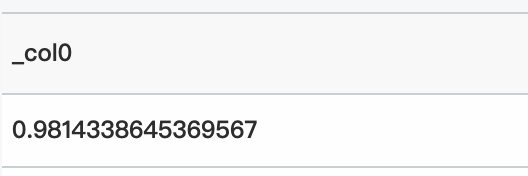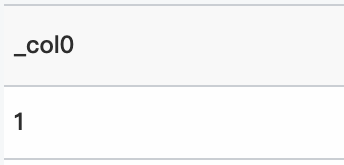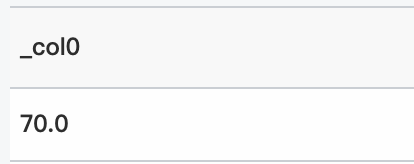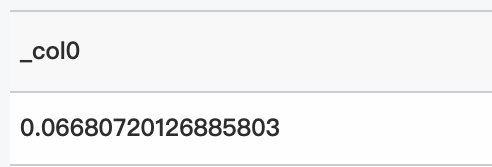This topic describes the syntax of mathematical statistics functions. This topic also provides examples on how to use the functions.
The following table describes the mathematical statistics functions that are supported by Simple Log Service.
Category | Function | Syntax | Description | Supported in SQL | Supported in SPL |
Correlation function | corr(x, y) | Returns the coefficient of correlation between x and y. The return value is in the range of [0,1]. | √ | × | |
Variance and standard deviation functions | covar_pop(x, y) | Returns the population covariance of x and y. | √ | × | |
covar_samp(x, y) | Returns the sample covariance of x and y. | √ | × | ||
stddev(x) | Returns the sample standard deviation of x. This function is equivalent to the stddev_samp function. | √ | × | ||
stddev_samp(x) | Returns the sample standard deviation of x. | √ | × | ||
stddev_pop(x) | Returns the population standard deviation of x. | √ | × | ||
variance(x) | Returns the sample variance of x. This function is equivalent to the var_samp function. | √ | × | ||
var_samp(x) | Returns the sample variance of x. | √ | × | ||
var_pop(x) | Returns the population variance of x. | √ | × | ||
Linear regression functions | regr_intercept(y, x) | Returns the y-intercept of the line for the linear equation that is determined by the | √ | × | |
regr_slope(y, x) | Returns the slope of the line for the linear equation that is determined by the | √ | × | ||
Cumulative distribution functions (CDFs) | beta_cdf(α, β, v) | Returns a value for the beta distribution. The function uses the following formula: P(N <= v; α, β), where α and β are parameters for the beta CDF. | √ | × | |
binomial_cdf(x, y, v) | Returns a value for the binomial distribution. The function uses the following formula: P(N <= v), where x indicates the number of trials, and y indicates the probability of success (POS) of a trial. | √ | × | ||
cauchy_cdf(x, y, v) | Returns a value for the Cauchy distribution. The function uses the following formula: P(N <= v; x, y), where x is the location parameter indicating the peak of the distribution, and y is the scale parameter. | √ | × | ||
chi_squared_cdf(k, v) | Returns a value for the chi-square distribution. The function uses the following formula: P(N <= v; k), where k indicates the degree of freedom. | √ | × | ||
inverse_beta_cdf(α, β, p) | Returns a value for the inverse of the beta distribution. p indicates the result of the beta CDF, which uses the P(N <= v; α, β) formula. The inverse inverse_beta_cdf function calculates v. | √ | × | ||
inverse_binomial_cdf(x, y, p) | Returns a value for the inverse of the binomial distribution. p indicates the result of the binomial CDF, which uses the P(N <= v) formula. The inverse inverse_binomial_cdf function calculates v. | √ | × | ||
inverse_cauchy_cdf(x, y, p) | Returns a value for the inverse of the Cauchy distribution. p indicates the result of the Cauchy CDF, which uses the P(N <= v; x, y) formula. The inverse inverse_cauchy_cdf function calculates v. | √ | × | ||
inverse_chi_squared_cdf(k, p) | Returns a value for the inverse of the chi-square distribution. p indicates the result of the chi-square CDF, which uses the P(N <= v; k) formula. The inverse inverse_chi_squared_cdf function calculates v. | √ | × | ||
inverse_laplace_cdf(μ, b, p) | Returns a value for the inverse of the Laplace distribution. p indicates the result of the Laplace CDF, which uses the P(N <= v; μ, b) formula. The inverse inverse_laplace_cdf function calculates v. | √ | × | ||
inverse_normal_cdf(x, y, p) | Returns a value for the inverse of the normal distribution. p indicates the result of the normal CDF, which uses the P(N < v; x, y) formula. The inverse inverse_normal_cdf function calculates v. | √ | × | ||
inverse_poisson_cdf(x, y, p) | Returns a value for the inverse of the Poisson distribution. p indicates the result of the Poisson CDF, which uses the P(N <= v; λ) formula. The inverse inverse_poisson_cdf function calculates v. | √ | × | ||
inverse_weibull_cdf(x, y, p) | Returns a value for the inverse of the Weibull distribution. p indicates the result of the Weibull CDF, which uses the P(N <= v; x, y) formula. The inverse inverse_weibull_cdf function calculates v. | √ | × | ||
laplace_cdf(μ, b, v) | Returns a value for the Laplace distribution. The function uses the following formula: P(N <= v; μ, b), where μ is the location parameter, and b is the scale parameter. | √ | × | ||
normal_cdf(x, y, v) | Returns a value for the normal distribution. The function uses the following formula: P(N < v; x, y), where x indicates the mean value for the normal distribution, and y indicates the standard deviation for the normal distribution. | √ | × | ||
poisson_cdf(λ, v) | Returns a value for the Poisson distribution. The function uses the following formula: P(N <= v; λ), where λ indicates the average probability of random events. | √ | × | ||
weibull_cdf(x, y, v) | Returns a value for the Weibull distribution. The function uses the following formula: P(N <= v; x, y), where x is the scale parameter, and y is the shape parameter. | √ | × |
corr function
The corr function returns the coefficient of correlation between x and y. A larger return value indicates a higher correlation.
Syntax
corr(x, y)Parameters
Parameter | Description |
x | The value of this parameter is of the double type. |
y | The value of this parameter is of the double type. |
Return value type
The double type. The return value is in the range of [0,1].
Examples
Calculate the coefficient of correlation between the values of the request_length and request_time fields.
Query statement
* | SELECT corr(request_length,request_time)Query and analysis results

covar_pop function
The covar_pop function returns the population covariance of x and y.
Syntax
covar_pop(x, y)Parameters
Parameter | Description |
x | The value of this parameter is of the double type. |
y | The value of this parameter is of the double type. |
Return value type
The double type.
Examples
Calculate the population covariance of pretax profits and pretax turnovers in each minute.
Query statement
*| SELECT covar_pop(PretaxGrossAmount, PretaxAmount) AS "Population covariance", time_series(__time__, '1m', '%H:%i:%s', '0') AS time GROUP BY timeQuery and analysis results

covar_samp function
The covar_samp function returns the sample covariance of x and y.
Syntax
covar_samp(x, y)Parameters
Parameter | Description |
x | The value of this parameter is of the double type. |
y | The value of this parameter is of the double type. |
Return value type
The double type.
Examples
Calculate the sample covariance of pretax profits and pretax turnovers in each minute.
Query statement
*| SELECT covar_samp(PretaxGrossAmount, PretaxAmount) AS "Sample covariance", time_series(__time__, '1m', '%H:%i:%s', '0') AS time GROUP BY timeQuery and analysis results

stddev function
The stddev function returns the sample standard deviation of x. This function is equivalent to the stddev_samp function.
Syntax
stddev(x)Parameters
Parameter | Description |
x | The value of this parameter is of the double or bigint type. |
Return value type
The double type.
Examples
Calculate the sample standard deviation and population standard deviation of pretax incomes and display the calculated values in a line chart.
Query statement
* | SELECT stddev(PretaxGrossAmount) as "Sample standard deviation", stddev_pop(PretaxGrossAmount) as "Population standard deviation", time_series(__time__, '1m', '%H:%i:%s', '0') AS time GROUP BY timeQuery and analysis results

stddev_samp function
The stddev_samp function returns the sample standard deviation of x.
Syntax
stddev_samp(x)Parameters
Parameter | Description |
x | The value of this parameter is of the double or bigint type. |
Return value type
The double type.
Examples
Calculate the sample standard deviation and population standard deviation of pretax incomes and display the calculated values in a line chart.
Query statement
* | SELECT stddev_samp(PretaxGrossAmount) as "Sample standard deviation", stddev_pop(PretaxGrossAmount) as "Population standard deviation", time_series(__time__, '1m', '%H:%i:%s', '0') AS time GROUP BY timeQuery and analysis results

stddev_pop function
The stddev_pop function returns the population standard deviation of x.
Syntax
stddev_pop(x)Parameters
Parameter | Description |
x | The value of this parameter is of the double or bigint type. |
Return value type
The double type.
Examples
Calculate the sample standard deviation and population standard deviation of pretax incomes and display the calculated values in a line chart.
Query statement
* | SELECT stddev(PretaxGrossAmount) as "Sample standard deviation", stddev_pop(PretaxGrossAmount) as "Population standard deviation", time_series(__time__, '1m', '%H:%i:%s', '0') AS time GROUP BY timeQuery and analysis results

variance function
The variance function returns the sample variance of x. This function is equivalent to the var_samp function.
Syntax
variance(x)Parameters
Parameter | Description |
x | The value of this parameter is of the double or bigint type. |
Return value type
The double type.
Examples
Calculate the sample variance and population variance of pretax incomes and display the calculated values in a line chart.
Query statement
* | SELECT variance(PretaxGrossAmount) as "Sample variance", var_pop(PretaxGrossAmount) as "Population variance", time_series(__time__, '1m', '%H:%i:%s', '0') as time GROUP BY timeQuery and analysis results

var_samp function
The var_samp function returns the sample variance of x.
Syntax
var_samp(x)Parameters
Parameter | Description |
x | The value of this parameter is of the double or bigint type. |
Return value type
The double type.
Examples
Calculate the sample variance and population variance of pretax incomes and display the calculated values in a line chart.
Query statement
* | SELECT var_samp(PretaxGrossAmount) as "Sample variance", var_pop(PretaxGrossAmount) as "Population variance", time_series(__time__, '1m', '%H:%i:%s', '0') as time GROUP BY timeQuery and analysis results

var_pop function
The var_pop function returns the population variance of x.
Syntax
var_pop(x)Parameters
Parameter | Description |
x | The value of this parameter is of the double or bigint type. |
Return value type
The double type.
Examples
Calculate the sample variance and population variance of pretax incomes and display the calculated values in a line chart.
Query statement
* | SELECT variance(PretaxGrossAmount) as "Sample variance", var_pop(PretaxGrossAmount) as "Population variance", time_series(__time__, '1m', '%H:%i:%s', '0') as time GROUP BY timeQuery and analysis results

regr_intercept function
The regr_intercept function returns the y-intercept of the line for the linear equation that is determined by the (x,y) pair. x is the dependent value. y is the independent value.
Syntax
regr_intercept(y, x)Parameters
Parameter | Description |
y | The value of this parameter is of the double type. |
x | The value of this parameter is of the double type. |
Return value type
The double type.
Examples
Calculate the y-intercept of the line for the linear equation that is determined by the values of the request_time and request_length fields.
Query statement
* | SELECT regr_intercept(request_length,request_time)Query and analysis results

regr_slope function
The regr_slope function returns the slope of the line for the linear equation that is determined by the (x,y) pair. x is the dependent value. y is the independent value.
Syntax
regr_slope(y, x)Parameters
Parameter | Description |
y | The value of this parameter is of the double type. |
x | The value of this parameter is of the double type. |
Return value type
The double type.
Examples
Calculate the slope of the line for the linear equation that is determined by the values of the request_time and request_length fields.
Query statement
* | SELECT regr_slope(request_length,request_time)Query and analysis results

beta_cdf function
The beta_cdf function returns a value for the beta distribution.
Syntax
beta_cdf(α, β, v)Parameters
Parameter | Description |
α | The parameter for the beta CDF. The value of this parameter is of the double type. The value is greater than 0. |
β | The parameter for the beta CDF. The value of this parameter is of the double type. The value is greater than 0. |
v | The input parameter for the beta CDF. The value of this parameter is of the double type. Value range: [0,1]. |
Return value type
The double type.
Examples
Query statement
* | SELECT beta_cdf(0.1, 0.5, 0.7)Query and analysis results

binomial_cdf function
The binomial_cdf function returns a value for the binomial distribution.
Syntax
binomial_cdf(x, y, v)Parameters
Parameter | Description |
x | The number of trials. The value of this parameter is of the integer type. The value is greater than 0. |
y | The POS of a trial. The value of this parameter is of the double type. Value range: [0,1]. |
v | The input parameter for the binomial CDF. The value of this parameter is of the integer type. |
Return value type
The double type.
Examples
Query statement
* | select binomial_cdf(10, 0.1, 1)Query and analysis results

cauchy_cdf function
The cauchy_cdf function returns a value for the Cauchy distribution.
Syntax
cauchy_cdf(x, y, v)Parameters
Parameter | Description |
x | The location parameter that indicates the peak of the distribution. The value of this parameter is of the double type. |
y | The scale parameter. The value of this parameter is of the double type. The value must be greater than 0. |
v | The input parameter for the Cauchy CDF. The value of this parameter is of the double type. |
Return value type
The double type.
Examples
Query statement
* | select cauchy_cdf(-10, 5, -12)Query and analysis results

chi_squared_cdf function
The chi_squared_cdf function returns a value for the chi-square distribution.
Syntax
chi_squared_cdf(k, v)Parameters
Parameter | Description |
k | The degree of freedom. The value of this parameter is of the double type. The value is greater than 0. |
v | The input parameter of the chi-square CDF. The value of this parameter is of the double type. The value is greater than or equal to 0. |
Return value type
The double type.
Examples
Query statement
* | select chi_squared_cdf(3, 10)Query and analysis results

inverse_beta_cdf function
The inverse_beta_cdf function returns a value for the inverse of the beta distribution.
Syntax
inverse_beta_cdf(α, β, p)Parameters
Parameter | Description |
α | The parameter for the beta CDF. The value of this parameter is of the double type. The value is greater than 0. |
β | The parameter for the beta CDF. The value of this parameter is of the double type. The value is greater than 0. |
p | The input parameter for the inverse of the beta CDF. The value of this parameter is of the double type. Value range: [0,1]. |
Return value type
The double type.
Examples
Query statement
* | select inverse_beta_cdf(0.1, 0.5, 0.8926585878364057)Query and analysis results

inverse_binomial_cdf function
The inverse_binomial_cdf function returns a value for the inverse of the binomial distribution.
Syntax
inverse_binomial_cdf(x, y, p)Parameters
Parameter | Description |
x | The number of trials. The value of this parameter is of the integer type. The value is greater than 0. |
y | The POS of a trial. The value of this parameter is of the double type. Value range: [0,1]. |
p | The input parameter for the inverse of the binomial CDF. The value of this parameter is of the double type. Value range: [0,1]. |
Return value type
The integer type.
Examples
Query statement
* | select inverse_binomial_cdf(10, 0.1, 0.7360989291000001)Query and analysis results

inverse_cauchy_cdf function
The inverse_cauchy_cdf function returns a value for the inverse of the Cauchy distribution.
Syntax
inverse_cauchy_cdf(x, y, p)Parameters
Parameter | Description |
x | The location parameter that indicates the peak of the distribution. The value of this parameter is of the double type. |
y | The scale parameter. The value of this parameter is of the double type. The value is greater than 0. |
p | The input parameter for the inverse of the Cauchy CDF. The value of this parameter is of the double type. Value range: [0,1]. |
Return value type
The double type.
Examples
Query statement
* | select inverse_cauchy_cdf(-10, 5, 0.3788810584091566)Query and analysis results

inverse_chi_squared_cdf function
The inverse_chi_squared_cdf function returns a value for the inverse of the chi-square distribution.
Syntax
chi_squared_cdf(k, p)Parameters
Parameter | Description |
k | The degree of freedom. The value of this parameter is of the double type. The value is greater than 0. |
p | The input parameter for the inverse of the chi-square CDF. The value of this parameter is of the double type. Value range: [0,1]. |
Return value type
The double type.
Examples
Query statement
* | select inverse_chi_squared_cdf(3, 0.9814338645369567)Query and analysis results

inverse_laplace_cdf function
The inverse_laplace_cdf function returns a value for the inverse of the Laplace distribution.
Syntax
inverse_laplace_cdf(μ, b, p)Parameters
Parameter | Description |
μ | The location parameter for the Laplace CDF. The value of this parameter is of the double type. |
b | The scale parameter for the Laplace CDF. The value of this parameter is of the double type. The value is greater than 0. |
p | The input parameter for the inverse of the Laplace CDF. The value of this parameter is of the double type. Value range: [0,1]. |
Return value type
The double type.
Examples
Query statement
* | select inverse_laplace_cdf(11, 0.5, 0.18393972058572118)Query and analysis results

inverse_normal_cdf function
The inverse_normal_cdf function returns a value for the inverse of the normal distribution.
Syntax
inverse_normal_cdf(x, y, p)Parameters
Parameter | Description |
x | The mean value for the normal distribution. The value of this parameter is of the double type. |
y | The standard deviation for the normal distribution. The value of this parameter is of the double type. The value is greater than 0. |
p | The input parameter for the inverse of the normal CDF. The value of this parameter is of the double type. Valid values: (0,1). |
Return value type
The double type.
Examples
Query statement
* | select inverse_normal_cdf(85, 10, 0.06680720126885803)Query and analysis results

inverse_poisson_cdf function
The inverse_poisson_cdf function returns a value for the inverse of the Poisson distribution.
Syntax
inverse_poisson_cdf(λ, p)Parameters
Parameter | Description |
λ | The average probability of random events. |
p | The input parameter for the inverse of the Poisson CDF. The value of this parameter is of the double type. Value range: [0,1]. |
Return value type
The integer type.
Examples
Query statement
* | select inverse_poisson_cdf(0.1, 0.9953211598395556)Query and analysis results

inverse_weibull_cdf function
The inverse_weibull_cdf function returns a value for the inverse of the Weibull distribution.
Syntax
inverse_weibull_cdf(x, y, p)Parameters
Parameter | Description |
x | The scale parameter for the Weibull CDF. The value of this parameter is of the double type. The value is greater than 0. |
y | The shape parameter for the Weibull CDF. The value of this parameter is of the double type. The value is greater than 0. |
p | The input parameter for the inverse of the Weibull CDF. The value of this parameter is of the double type. Valid values: [0,1]. |
Return value type
The double type.
Examples
Query statement
* | select inverse_weibull_cdf(1, 5, 0.3296799539643607)Query and analysis results

laplace_cdf function
The laplace_cdf function returns a value for the Laplace distribution.
Syntax
laplace_cdf(μ, b, v)Parameters
Parameter | Description |
μ | The location parameter for the Laplace CDF. The value of this parameter is of the double type. |
b | The scale parameter for the Laplace CDF. The value of this parameter is of the double type. The value is greater than 0. |
v | The input parameter for the Laplace CDF. The value of this parameter is of the double type. |
Return value type
The double type.
Examples
Query statement
* | select laplace_cdf(11, 0.5, 10.5)Query and analysis results

normal_cdf function
The normal_cdf function returns a value for the normal distribution.
Syntax
normal_cdf(x, y, v)Parameters
Parameter | Description |
x | The mean value for the normal distribution. The value of this parameter is of the double type. |
y | The standard deviation for the normal distribution. The value of this parameter is of the double type. The value is greater than 0. |
v | The input parameter for the normal CDF. The value of this parameter is of the double type. |
Return value type
The double type.
Examples
Query statement
* | select normal_cdf(85, 10, 70)Query and analysis results

poisson_cdf function
The poisson_cdf function returns a value for the Poisson distribution.
Syntax
poisson_cdf(λ, v)Parameters
Parameter | Description |
λ | The average probability of random events. |
v | The input parameter for the Poisson CDF. The value of this parameter is of the integer type. The value is greater than or equal to 0. |
Return value type
The double type.
Examples
Query statement
* | select poisson_cdf(0.1, 1)Query and analysis results

weibull_cdf function
The weibull_cdf function returns a value for the Weibull distribution.
Syntax
weibull_cdf(x, y, v)Parameters
Parameter | Description |
x | The scale parameter for the Weibull CDF. The value of this parameter is of the double type. The value is greater than 0. |
y | The shape parameter for the Weibull CDF. The value of this parameter is of the double type. The value is greater than 0. |
v | The input parameter for the Weibull CDF. The value of this parameter is of the double type. |
Return value type
Examples
Query statement
* | select weibull_cdf(1, 5, 2)Query and analysis results
